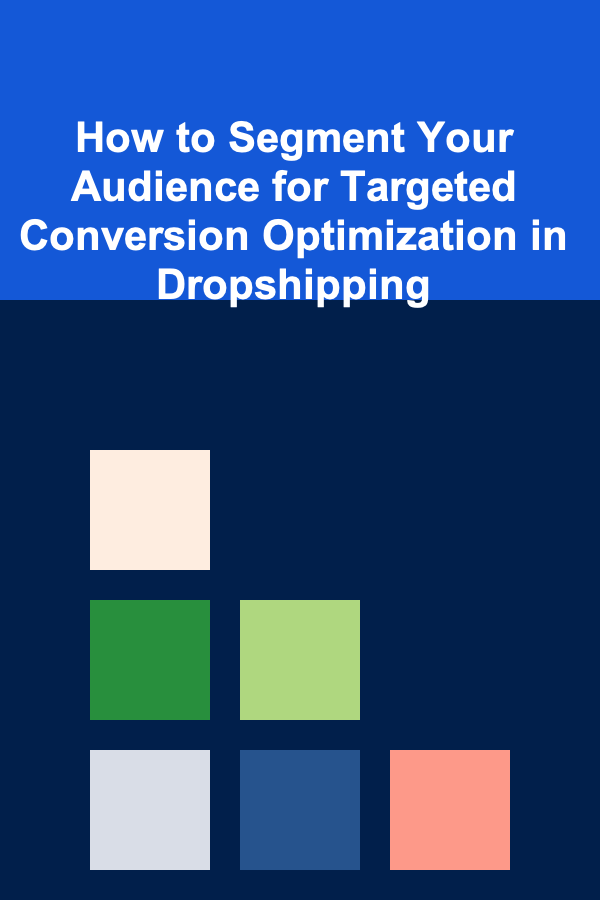
How to Segment Your Audience for Targeted Conversion Optimization in Dropshipping
ebook include PDF & Audio bundle (Micro Guide)
$12.99$5.99
Limited Time Offer! Order within the next:

Dropshipping is a business model that allows entrepreneurs to sell products without holding inventory. Instead, when an order is placed, the product is shipped directly from the supplier to the customer. While this model can be highly profitable, it is also highly competitive, and success largely depends on how well you can optimize your conversions.
To maximize conversions in your dropshipping business, one of the most effective strategies is audience segmentation. By dividing your customer base into distinct segments, you can tailor your marketing, sales tactics, and overall user experience to meet their specific needs, increasing the chances of turning prospects into loyal customers.
In this actionable guide, we will delve deep into the steps you can take to segment your audience for conversion optimization. By the end of this article, you'll have a comprehensive understanding of how to implement audience segmentation effectively and the tools to do so.
Why Audience Segmentation is Crucial for Dropshipping
In the context of dropshipping, audience segmentation helps you understand your customers better. Rather than treating everyone who visits your website as a generic "potential customer," segmentation allows you to identify and target specific groups with tailored messaging. This personalized approach results in a higher likelihood of engagement, and more importantly, conversions.
Here are some key reasons why segmentation is vital for dropshipping businesses:
- Improved targeting: When you target your audience effectively, your marketing messages resonate more with their interests, leading to better engagement and conversion rates.
- Increased relevance: Customers are more likely to buy from you if they feel that your offerings are customized to their needs.
- Better resource allocation: By focusing on the most profitable segments, you avoid wasting time and money on tactics that don't yield results.
Now, let's dive into the actionable steps for segmenting your audience in the dropshipping world.
Understand Your Audience
Before you start segmenting, it's essential to understand who your audience is. This involves gathering data, either through analytics tools, customer surveys, or market research, to get a clearer picture of your target demographics.
Key Factors to Consider:
- Demographics: Age, gender, location, and income level are all foundational demographic factors that can influence purchasing behavior.
- Psychographics: These refer to the interests, lifestyles, values, and attitudes of your customers. Understanding their motivations can help you tailor your offerings more effectively.
- Behavioral Data: This includes past purchasing behavior, website interactions, time spent on specific product pages, or engagement with certain marketing campaigns.
The goal here is to build a comprehensive profile of your ideal customers. Once you have gathered this data, you can segment your audience in various ways that will allow you to optimize for conversions.
Choose Your Segmentation Criteria
There are multiple ways to segment an audience, and the right approach depends on the unique characteristics of your dropshipping business and the products you sell. Below are some of the most common and effective methods of audience segmentation.
A. Demographic Segmentation
Demographic segmentation divides your audience based on measurable characteristics such as:
- Age: Certain products appeal to different age groups. For instance, beauty products may appeal more to younger individuals, while retirement planning tools might be relevant to older customers.
- Gender: Tailor your marketing campaigns to reflect the preferences of different genders. If you're selling fashion, offering gender-specific product lines can lead to better conversions.
- Income Level: Segmenting by income helps you adjust pricing strategies. Luxury items or high-end products will resonate with higher-income groups, while budget-friendly alternatives may be more suitable for lower-income customers.
B. Geographic Segmentation
Location-based segmentation can be valuable for dropshipping businesses, particularly those that sell products that are geographically relevant. Some ways to use geographic segmentation:
- Country: Different countries often have distinct consumer behaviors and needs. For example, a product might sell better in one country than in another due to cultural or climatic differences.
- Urban vs. Rural: People living in urban areas might have different tastes, interests, and buying habits compared to those in rural areas.
- Climate/Weather: Weather-driven segmentation is useful if your products are season-dependent. Selling winter coats might be more effective in colder regions, while swimwear would be better marketed to those in warmer climates.
C. Behavioral Segmentation
Behavioral segmentation looks at how customers interact with your website, their buying patterns, and other relevant behaviors. Some common ways to segment based on behavior include:
- Purchase History: Group customers who have purchased similar products in the past. For example, upselling or cross-selling products that complement their previous purchases can increase conversion rates.
- Engagement Level: Segment users based on how often they interact with your content, including email open rates, click-through rates, or social media engagement.
- Cart Abandonment: Those who have added items to their cart but didn't check out may need a follow-up offer or reminder to complete the purchase.
D. Psychographic Segmentation
Psychographic segmentation is one of the most nuanced approaches to audience segmentation. It focuses on the lifestyle, interests, and motivations of your customers. For dropshipping businesses, this could involve:
- Lifestyle: Segment customers based on their hobbies or lifestyles. For example, if you sell outdoor gear, you can target customers who are passionate about hiking, camping, or adventure sports.
- Values and Beliefs: Understanding your customers' core values---such as environmental consciousness or ethical concerns---can help you position your products in a way that resonates with them.
Implement Segmentation Tactics for Conversion Optimization
Once you've identified the key segments within your audience, it's time to implement tactics to optimize conversions. This means customizing your marketing strategies, landing pages, and product offerings based on the unique needs of each segment.
A. Tailor Your Marketing Campaigns
- Email Campaigns: Segment your email list according to demographics, behavior, and engagement level. Personalize your messaging by sending relevant offers or content tailored to each segment's preferences.
- Social Media Ads: Use the targeting features on platforms like Facebook and Instagram to target specific groups based on location, age, or interest. Create custom ads and product offerings based on these segments.
- Paid Search: Implement paid search ads with keywords that align with each segment. For instance, targeting high-income individuals with premium keywords could drive more qualified traffic to your site.
B. Personalize the User Experience
- Landing Pages: Create personalized landing pages for different customer segments. For example, a page for people interested in fitness gear could feature related products and customer testimonials from fitness enthusiasts.
- Product Recommendations: Use tools that suggest products based on a customer's behavior or previous purchases. A "related products" section that is dynamically generated can boost conversions by showing items that are most likely to appeal to that particular visitor.
- Dynamic Pricing: Adjust pricing strategies based on customer segments. Offering discounts to first-time buyers or loyal customers can increase the likelihood of conversions.
C. Retargeting and Remarketing
One of the most powerful tools for improving conversion rates is remarketing. This tactic involves targeting users who have visited your website but didn't convert. Using segmentation, you can send personalized ads or emails to these users, reminding them of the products they viewed and offering incentives to encourage purchase.
For instance:
- Cart Abandonment: Send a reminder email or offer a discount to encourage those who left items in their cart to complete the purchase.
- Product Retargeting: Show ads for products that users viewed but didn't buy, offering a special promotion to entice them to return.
Continuously Monitor and Adjust Your Segmentation
Audience segmentation isn't a one-time task. As consumer behavior evolves, so too should your segmentation strategy. Continuously monitor your segments' performance and adjust accordingly.
Key Metrics to Track:
- Conversion Rates: Track how each segment is performing in terms of sales and overall conversions.
- Customer Lifetime Value (CLV): Analyze how different segments contribute to your long-term revenue.
- Bounce Rates and Engagement: Measure how engaged each segment is with your content. Higher engagement often correlates with higher conversion rates.
By continuously refining your segmentation and testing new strategies, you ensure that your approach remains relevant and that you're always targeting the most profitable customers.
Conclusion
Segmentation is a powerful strategy for optimizing conversions in dropshipping. By understanding the diverse needs of your customers and tailoring your marketing efforts to meet those needs, you significantly increase the likelihood of successful conversions. From demographic to psychographic and behavioral segmentation, there are many ways to categorize and target your audience more effectively.
Remember, the key is not just to segment, but to actively implement personalized strategies that speak directly to each group's needs, desires, and behaviors. With the right approach, audience segmentation can help your dropshipping business stand out in a crowded market, maximize customer satisfaction, and drive long-term success.

Earn Passive Income by Licensing Your Deep Learning Models
Read More
How to Monitor Your Property with Live Video Feeds for Better Security
Read More
How to Save for Retirement at Any Age
Read More
How to Use Technology to Track Your Home Inventory
Read More
Volunteering: The Secret to Gaining Experience and Networking
Read More
How To Deal with Negative Peer Influence
Read MoreOther Products

Earn Passive Income by Licensing Your Deep Learning Models
Read More
How to Monitor Your Property with Live Video Feeds for Better Security
Read More
How to Save for Retirement at Any Age
Read More
How to Use Technology to Track Your Home Inventory
Read More
Volunteering: The Secret to Gaining Experience and Networking
Read More